My parents Eileen and Max live in a 52-year-old townhouse in Foster City. Up until a few years ago they drove a gas car, heated their home with a gas-powered furnace, and warmed their water with a gas tank water heater. My mom hoped to replace the kitchen’s old electric stove with a new gas one. They were all-in on gas. Fast-forward to today and they are happily all-electric. My 82-year-old mom managed the process from start to finish, selecting products, interviewing and hiring contractors, working with Foster City on permits, and negotiating with the homeowner’s association to address aesthetics. They were the first in their association, and maybe in the whole city, to transform a gas-powered townhouse to an electric one.
I asked my Mom to write about her experience in case it would help some of you who are considering doing something similar. Here is what she says.
How hard can it be to electrify a 50-year-old townhouse in a planned community with an HOA? This is our experience and the lessons learned.

Our townhouse in Foster City, CA
It all began six years ago with a Honda Civic that had seen better days and a kitchen that was badly in need of a facelift. Replacing the car gave me the opportunity to lease an EV and see if I liked it. After measuring the space in the garage, the Chevy Spark was a perfect fit, so that is what I got. (Yes, always choose a car by size!) I got the 15-amp Voltec charger that the dealer suggested and it works fine, charging the battery overnight. (1) I liked the car enough that when the lease expired, I bought another one (a newer model, used).
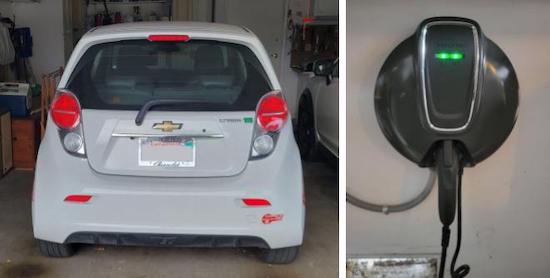
My 2016 Chevrolet Spark and its 15-amp charging station
The kitchen remodel was a bigger project and I was hoping to add gas, not remove it. The original kitchen had an electric stove and I wanted to switch to gas so I could make quick adjustments to the heat. I love to cook and the old stove was very slow to respond. But it was expensive to get a gas line into the kitchen so I learned about induction ranges, which were the perfect answer. The induction cooking surface not only adjusts the heat quickly, it is better than gas in a few ways. It is easier to clean, and it is safer since the heating areas remain cool unless covered by a pot. My husband thinks I love that cooktop more than him.
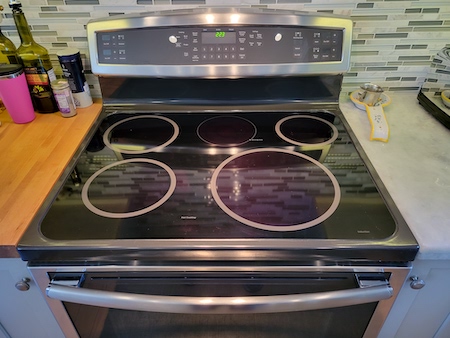
I love my GE induction range
Up to this point, our focus was more on keeping to a budget than on saving the planet. The stove was the best option for the remodel and the car was inexpensive and great for most of the driving we do. (My husband has a gas-powered Subaru Crosstrek that we use for longer drives.)
But during the next few years I read more and more about fossil fuels (bad) and clean energy (good). I read Sherry’s blogs. I timed my car charging and my cooking with clean energy in mind. I changed the light bulbs to LEDs. And at some point I thought, why not just electrify the whole house? But first I had to consider our electric panel and the costs.
The Electric Panel
We have a 125-amp electric panel. The kitchen range has a 40-amp breaker and the EV charger has a 20-amp breaker. We have a 30-amp breaker for the dryer and then smaller breakers for things like outlets and lights and kitchen appliances. We still had slots open. I hoped our panel would be enough since upgrading to 200 amps would involve major excavation through HOA territory. That was pretty much off the table. Fortunately the contractors confirmed that my plan for electrification would be fine.

The label on our 1970 electric service showing 125 amps
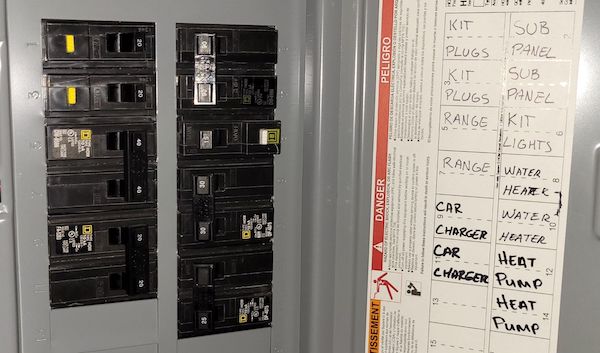
The electric panel shows our new appliances (older laundry and kitchen appliances are on a subpanel).
The Costs
I knew that electrifying was going to cost us some money. But we had lived in the house for 21 years without doing much work on it, and we hadn’t been traveling the past few years so we could afford it. I thought that since we could do it, we should do it, and maybe that would help others down the road. I was also curious how hard it would be. Our kitchen remodel had gone very well, on budget and with no cost overruns. There were no issues with permits or equipment delays. Could we manage this just as well? I wanted to try.
My husband was not so enthusiastic. Our water heater wasn’t broken, though we weren’t sure how old it was. We could live without the air conditioning that we would be getting. Our heating seemed fine. Why go through this hassle? But he generally approved of the environmental goals and I had the encouragement of our kids and my brother who have all done a lot of electrification. I forged ahead.
First the Heat Pump Water Heater
Our gas tank water heater was located in a closet off the garage. It was near an electrical panel and adjacent to an outside wall (for drainage). So that made it pretty straight-forward to install a heat pump water heater (HPWH), though the confined space made it tricky to fit everything in.
Our power provider is Peninsula Clean Energy, so I used their website to find a few contractors and interview them. I wanted someone local and I wanted to get the rebate. I chose one and they came and did the work. Our heat pump water heater was installed in August 2021.
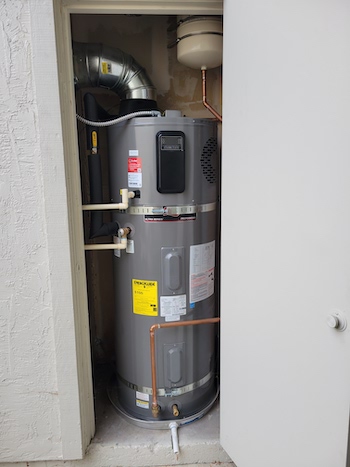
Our 65 gallon Rheem HPWH in an outside closet.
It sounds simple but I learned some lessons along the way.
Lesson #1: Plan ahead. The contractors are pretty busy, especially the good ones, and these installations can take time. If possible, do the electrical work in advance, maybe when you have an electrician coming to do something else. Not all equipment is readily available, so if there’s a particular type of water heater you want that’s not very common, you might also order that in advance.
Lesson #2: Choose an experienced contractor. You will want to use a contractor with experience working in your city. Make sure they and their subcontractors are licensed to work in your city. Ask how many heat pump water heaters they have installed, and installed in your city. Check if they have experience getting permits in your city.
Lesson #3: Withhold part of the final payment just in case. Make sure you have agreed on what is needed for the project to be complete (water heater installed? inspection passed? rebate in hand? phone app working?) Then withhold final payment until those things are done to your satisfaction.
I learned those lessons the hard way.
I got estimates from three contractors. One in San Jose was less expensive but declined to do the job because he didn’t want to deal with permits in Foster City. Another seemed to really know what he was doing, but he couldn’t do the installation for several months and the rebates were due to be reduced soon. So I went with the third option, which did not work out so well.
When the plumber set the installation date, I asked if he had a permit. He said no, so I insisted he get one. The next day he gave me the permit number. The installation was completed before I realized that A PERMIT NUMBER IS NOT A PERMIT. The contractor did not in fact get a permit to do the work because he was using an electrician who was not licensed to work in Foster City. That would have cost him more money. This was a real nuisance for me to figure out. The permit department and I were on speed dial, my car could find its way to the plumber’s office by itself and the small claims court forms were filled out. Six months later, the contractor finally hired an electrician licensed in our city and completed the application. An inspection was arranged and I got the actual permit and passed inspection. The plumber had done an excellent job. The $2150 total in rebates from BayRen and Peninsula Clean Energy also took time to get since I had to keep after the plumber to process the applications. The total cost was about $5000 including rebates. (2)
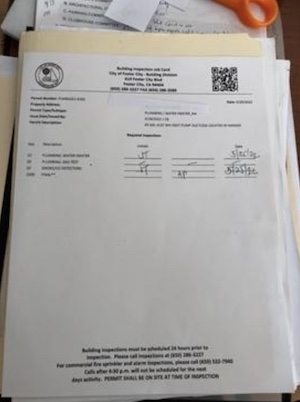
Six months for this final inspection approval?
If I were to do this again, I would get a 15-amp heat pump water heater to save room in the electric panel. But they weren’t in stock when I did this.
We have not noticed any significant increase in our electric bills since the HPWH installation. That is not surprising since we don’t use all that much hot water, plus our gas costs went down while our electric costs went up.
Last week we received an invitation to connect our HPWH to Watter-Saver. That was easy to do, and now PG&E can adjust when our water heater runs to save on costs, and we can continue to pay no attention to it. We also get $5/month for participating.
On to the Space Heating
Our townhouse was heated by a gas furnace sitting in an upstairs closet. It pushed warm air out through ducts in the house that lead to vents like this one.
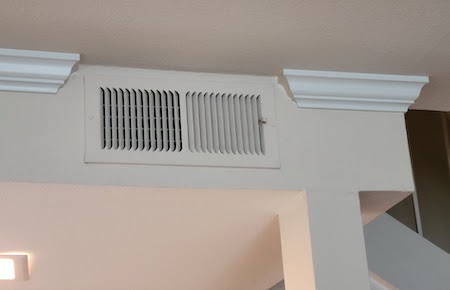
Vents like this in each room connected to a gas furnace in an upstairs hall closet.
We wanted the vents to just keep working, but for that to happen we knew that the ducts needed to be in decent shape since a heat pump isn’t as powerful as a furnace. Unfortunately we failed the duct test with flying colors, which reported “... the rater was unable to fully pressurize the duct system. Almost 70% duct leakage”.
So I brought in a contractor to discuss options like mini-splits, or even using gas heat upstairs and electric heat for the main living area downstairs. But since we really wanted the vents to “just work”, I hired a duct specialist (who knew?) who said that with a bit of work the ducts would be fine. (3)
To do the installation, I hired the company that had been my #1 choice for the heat pump water heater, Alternative HVAC Solutions. They were also recommended as Mitsubishi installers, the brand I favored. One decision we had to make was where to put the exterior unit. That was easy for us because of HOA and city regulations -- it would go on our back patio. We have a large patio with some extra room to the side, and we chose a 3-ton Mitsubishi unit that is fairly quiet. (4)

You can just see the outdoor unit peeking up above the fence. The contractor did a nice job matching colors.
It took four months for the heat pump to arrive, but once it came it was installed in two days by 3-4 excellent workers. They did a really nice job replacing the gas furnace with a ducted air handler. That is an indoor unit that sends heated or cooled air through the ducts, assisted by refrigerated lines coming in from the outdoor unit. The new equipment is quieter than the gas furnace that it replaced.
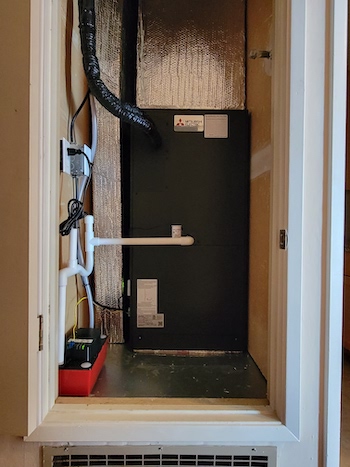
The ducted air handler fits in nicely where the gas furnace used to be.
We passed a repeat duct testing! Well, we passed with “an allowable duct leakage (cfm) of 180 and an actual duct leakage of 737.” Sounds more like a D- to me. Apparently an old house with “non-accessible portions of the duct system” gets a break. Hurray for our second floor and old ducts.
I paid extra for Alternative HVAC to do the city permit applications. The cost was $17,379 including the duct repair, the repeat duct testing, and all the paperwork for permits, rebates, etc. They managed it all with no problem. The rebates totaled $2650, with $2500 from Tech Clean CA Incentive and $150 from BayRen. This time I only had to worry about the HOA permit. That brings me to the first lesson learned on this project.
Lesson #4: Be patient with HOAs. Getting HOA approval can take a while since they may not have seen these projects before. Be patient and agree immediately when the HOA says they’d like to think of this as an air conditioner.
And there was also this lesson.
Lesson #5: Duct testing can be confusing. It turns out a really bad duct test doesn’t have to stop a project like this. Instead, they fixed many of the leaks and made our heating system more efficient.
And this one.
Lesson #6: See Lesson #1. Supply chain disruption is real. Equipment can take weeks or even months to arrive. Check with your contractor and stay flexible, or pre-order if you know what you want.
You might be wondering “Is it working?” The warm air and cold air are both working well, in every room, even one that was previously unconnected. I want to go through a winter of heating before reporting back on bills and the outdoor fan, but so far it all seems fine. (5)
I’m still not completely done. The outdoor fan should ideally be in a shady spot but ours is in the sun. That can be good for heating but harder for cooling. So one thing we may do is add some plants or other screening to help shade it. But only if it doesn’t require more permits! I’d be interested in any good ideas for this.
I’m also almost approved for solar panels. No one in our HOA has these yet, so it’s taken months to get to this point. We needed a lawyer to write up new rules, a 30-day review period by all 243 owners, and then a review by the Architecture Committee. I’ve been shepherding this for almost 3 months. (Remember that point about planning ahead and allowing for delays?) Our electric panel seems to have just enough space for this, and I’m optimistic that it will work out. I am getting attached to my unpaid project manager job and my husband seems to find it all rather amusing.
Are we glad we have an all-electric townhouse? How will we feel when the cool winter and hotter summers and our electric bills arrive? Despite the stress, frustration, and second guessing along the way, it was worth it. It comes back to my original rationale. It is not cost effective yet but it felt like the right thing to do. I’m sure we are at the beginning of a massive conversion to clean energy. We have to be. I am happy to do my part now and maybe make it a little easier for others. It was challenging but doable. I hope the lessons I learned will be helpful for some of you. We will continue to monitor our energy use and our bills. Neighbors are already expressing interest, which is great. And my husband is quite engaged in monitoring our new system.
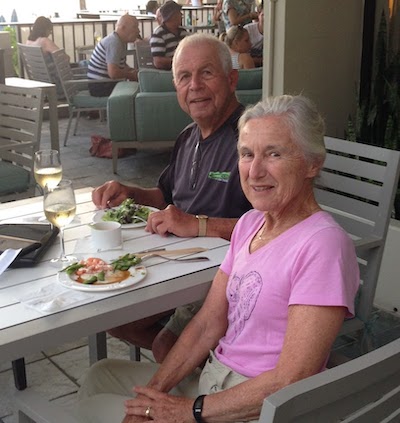
Max and Eileen Listgarten
Coming soon: Visit up to 20 homes this Saturday, September 24. Check out the Green & Electrified Home Tour on September 24 from 10am to 4pm to see electrified homes near you. It is a free tour featuring 20 homes -- 5 in Palo Alto, 8 in Santa Clara County south of Palo Alto, and 7 in San Mateo County. Homeowners will share information about the appliances they have selected, costs, contractors used (or if done do-it-yourself), and financing. Some are still in the process of becoming fully electric, and you can ask about their decision-making process in choosing where to start first. City of Palo Alto Utilities will be sponsoring EV viewing at several sites. Register here if you are interested in attending.
And on Friday, September 23. Palo Altans who want the city to provide more support for electrification can join a rally at King Plaza on Friday, September 23 from 5:00 pm to 7:00 pm. The climate groups and students attending are asking Palo Alto to pass its Sustainability and Climate Action Plan on September 27 and to provide more help for residents who want to install a heat pump water heater.
Notes and References
1. Note from Sherry: My mom’s Chevrolet Spark has a 3.3 KW onboard charger, so the 15-amp Voltec is a good fit. (15 amps * 240 volts = 3.6 KW.) The 3.3 KW onboard charger can charge the 19 kWh battery in 19 kWh / 3.3 KW = 5.8 hours. An EV with a larger battery will typically have a more powerful onboard charger, and that can benefit from a more powerful home charging station (e.g., 30-amp) though a smaller one is often plenty for most driving needs. (You can typically drive 4 miles per kWh, so 3.5 KW * 10 hours = 35 kWh is about 140 miles on a 10-hour, 15-amp charge.)
2. Note from Sherry: The cost of my parents’ HPWH was more than it should have been, as I wrote about earlier. My parents were okay with the cost, but we cannot expect widespread adoption at that kind of price. Equipment and labor costs need to come down as state and local policies drive demand.
3. Note from Eileen: As an aside, I also learned that the duct outlet (vent) in one upstairs room was never connected. Apparently that room had not been heated in the 20 years we have lived here. Now it works!
4. Note from Eileen: In addition to the unit being very quiet, we don’t use the patio much when it’s cold enough for the heat to be on, or when it’s hot enough for the air conditioner to be on. If one day we are using the patio and the unit is running and we find the sound to be bothersome, we can turn it off for that period. So this placement works out well for us, and we have seen air conditioners in similar spots.
5. Note from Sherry: I looked at my parents’ PG&E bills for January and February of last year, the two coldest months when they used the most gas. They show 54 and 44 therms of gas, respectively, at about $2.18/therm. Their gas heating bill was about $110 (and it was only for gas heating, since everything else was electric), and their total bill (gas + electric) was about $220. What would their bill look like on a cold winter month with their new efficient electric heat?
Let’s assume a “typical” winter month where they would have used 50 therms of gas. At $2.18/therm, that costs $109. Their new heater uses electricity, which is more expensive than gas, but luckily their new heater is also much more efficient than a gas heater. Their unit has an impressive HSPF of 11.7, which translates to an efficiency of 3.43 (3.43 = 11.7 / 3.412 as explained here). That is, it produces 3.43 times more energy than it takes in, on average over the heating season.
If my parents need 50 therms to heat their home, then that means they could need up to 427 kWh of electricity (50 therms * 29.3 kWh/therm / 3.43) to heat their home. In practice it is likely to be less because (a) their old furnace was not 100% efficient and (b) they fixed a bunch of duct leaks. In other words, some of that 50 therms they paid for was wasted by the old furnace and leaky ducts, and not used to heat the house, so they won’t need the full 427 kWh. But the new heater may be somewhat less efficient during the coldest winter months, so let’s go with the full 427 kWh for now.
What does the additional electricity cost? Their winter electricity bills averaged $0.27/kWh, so 427 kWh would cost $115. That is only $6 more per month than the gas equivalent, barely noticeable when their total winter monthly PG&E bill is about $220. However, they will be paying more than $0.27/kWh for this additional electricity, closer to a Tier 2 rate. My parents have applied for and received a larger Tier 1 allowance because their house is all-electric. However, the additional Tier 1 allowance is only 5 kWh/day, and we are estimating they will need about 15 kWh/day. So two-thirds of their heating will be at a Tier 2 rate during the coldest months.
Given that, let’s say that they will be paying $0.33/kWh for their 427 kWh of electric heating in January and February. That is a $141 heating bill compared with $109 for gas, or an additional $1/day. In practice it may well be less as explained above. In warmer months they will be using less heat and paying a lower price for it. Their bill could even go down because of their very efficient heat and larger Tier 1 allowance. But in the coldest months, their total PG&E bill could be as high as $250, up from $220 with gas. I’m pretty sure my parents wouldn’t notice that if they weren’t looking very closely, but I thought it worth spelling out what they can expect for this blog post.
Current Climate Data (August 2022)
Global impacts, US impacts, CO2 metric, Climate dashboard
Comment Guidelines
I hope that your contributions will be an important part of this blog. To keep the discussion productive, please adhere to these guidelines or your comment may be edited or removed.
- Avoid disrespectful, disparaging, snide, angry, or ad hominem comments.
- Stay fact-based and refer to reputable sources.
- Stay on topic.
- In general, maintain this as a welcoming space for all readers.



